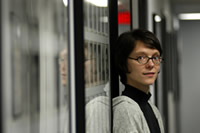Vol.
27 No. 2
March-April 2005
From the Editor
 There have been many efforts worldwide to increase public trust in the chemical industry, in specific chemical companies, and even in the science of chemistry in general. A feature article on “Responsible Care in Canada” (in print page 4) shows how a simple commitment to ethical behavior, openness, and responsiveness has greatly benefited Canadian society and the chemical industry. As Jean Bélanger describes, the Responsible Care movement has evolved over 25 years from three fundamental principles to which the industry committed itself: There have been many efforts worldwide to increase public trust in the chemical industry, in specific chemical companies, and even in the science of chemistry in general. A feature article on “Responsible Care in Canada” (in print page 4) shows how a simple commitment to ethical behavior, openness, and responsiveness has greatly benefited Canadian society and the chemical industry. As Jean Bélanger describes, the Responsible Care movement has evolved over 25 years from three fundamental principles to which the industry committed itself:
- doing the right thing
- caring about products from cradle to grave
- being open and responsive to public concerns
These seemingly simple values are worth emulating.
In our own sphere, I believe that doing the right thing can mean asking questions. It is a pleasure, therefore, to announce the beginning of a new series on “Emerging Issues in Developing Countries” (in print page 16). According to Kip Powell, president of the Analytical Chemistry Division, the series will provide a forum for views and discussion on one of IUPAC’s goals, which is to “foster communication among individual chemists and scientific organizations, with special emphasis on the needs of chemists in developing countries.” The first article in this series rightly asks how can IUPAC facilitate international collaborative research.
Further examples of how IUPAC cares about its products can be found in the Project Place (in print page 20). Walter Benson presents a new cooperative project between IUPAC and IOCD in which analytical practices in emerging regions will be surveyed with the goals of improving how standards are met and establishing remedial measures to build analytical capacity.
At last, and following the principle of openness and responsiveness to the public, Lida Schoen eagerly reports on a project that took her, IUPAC, and Science Across the World to Taipei for a YAC day held in the world’s tallest building. Read on in Project Place (in print page 20) how this project encourages enthusiastic young ambassadors for chemistry to learn about the wonders of chemistry. Fabienne Meyers
[email protected]
Page
last modified 22 February 2005.
Copyright © 2003-2005 International Union of Pure and
Applied Chemistry.
Questions regarding the website, please contact [email protected]
|